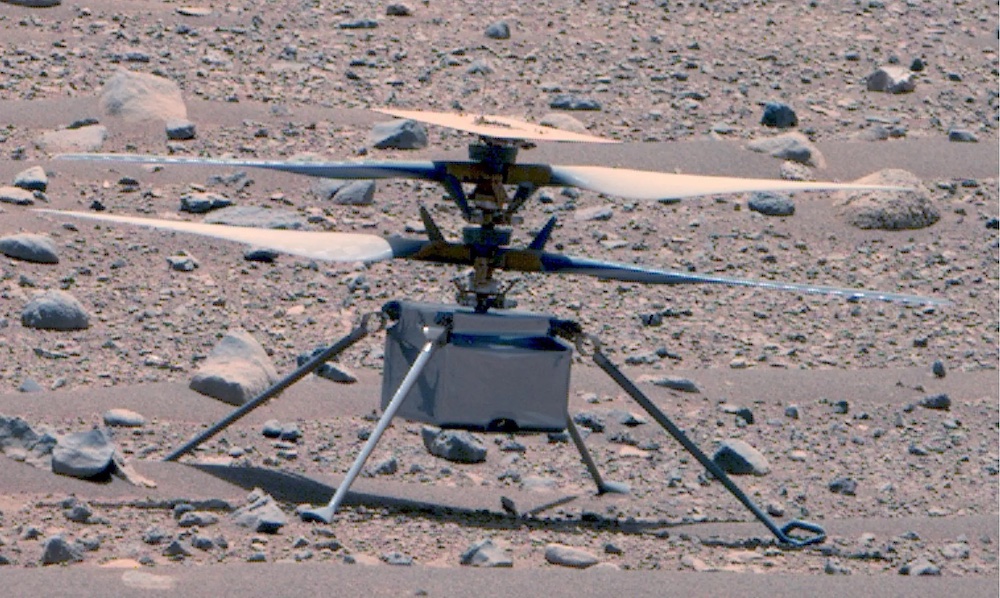NASA Ingenuity to play desk detective, collect data for Mars explorers
Ingenuity was the first aircraft to fly on another planet. Now it will collect data for future Mars explorers.

NASA’s Ingenuity team is finally saying goodbye to its historic Mars helicopter.
The Ingenuity team assembled for the last time on Tuesday, April 16, to oversee the helicopter’s final transmission.
The helicopter flew for the first time on April 19, 2021. It made history, becoming the first aircraft to perform a controlled flight on another planet.
It went on to exceed everyone’s expectations—Ingenuity was only expected to fly five times, but it took to the skies more than 70 times, serving as an aerial scout for the Perseverance rover.
Though it’s the last time the Ingenuity team at NASA’s Jet Propulsion Laboratory (JPL) will work together, Ingenuity still has a role to play. The groundbreaking Mars chopper will soon lose contact with Earth, but it will continue to collect data for future Mars explorers.
NASA’s Ingenuity takes on a new role
The final Ingenuity team meeting took place in a control room at NASA’s JPL in Southern California. According to NASA, the team ate “Final Comms” cake while looking over the last data of its historic mission, beamed to Earth from over 189 million miles (304 million kilometers) away.
Three months earlier, Ingenuity performed its 72nd and final flight. It damaged its rotors while landing, meaning it would never take off again.
“With apologies to Dylan Thomas, Ingenuity will not be going gently into that good Martian night,” Josh Anderson, Ingenuity team lead at JPL, explained in a NASA blog post.
“It is almost unbelievable that after over 1,000 Martian days on the surface, 72 flights, and one rough landing, she still has something to give,” Anderson continued. “And thanks to the dedication of this amazing team, not only did Ingenuity overachieve beyond our wildest dreams, but also it may teach us new lessons in the years to come.”
That “something to give” refers to the fact that Ingenuity is still capable of collecting scientific data. In other words, though the Ingenuity chopper won’t fly again, it will still live on as a stationary science payload and time capsule on Mars.
Over its 72 flights, Ingenuity stayed aloft for 129 minutes and covered 10.5 miles (17 km) of Martian ground. That is more than 14 times farther than it was originally expected to fly, according to NASA officials.
The helicopter’s longevity cast it as an against-the-odds success story. In an interview with IE last year, Ingenuity’s former lead electrical engineer Loay Elbasyouni said “everybody thought it was not gonna fly.”
Ingenuity’s legacy lives on
The 4-pound (1.8-kilogram) Ingenuity chopper reached Mars aboard NASA’s Perseverance rover in February 2021. When it flew for the first time two months later, it showed the world that controlled flight on other planets is possible.
The Ingenuity team had to account for Mars’ extremely thin atmosphere. Before leaving Earth, the Mars helicopter was fitted with a custom superlight rotor system with a 4-foot (1.2-meter) wingspan, allowing the aircraft to fly at 2,500 RPM—as a point of reference, helicopters on Earth typically fly at 400-500 RPM.
This allowed Ingenuity to explore the Jezero Crater, the ancient lakebed where the Perseverance rover is looking for signs of microbial alien life.
The helicopter’s success has paved the way for other missions. NASA’s Dragonfly, for example, is expected to launch in 2028. It will send a rotorcraft to explore Saturn’s largest moon, Titan, which features methane oceans and lakes on its surface.
Ingenuity can store 20 years of data for future explorers
During the Ingenuity team’s final meeting, the team reviewed the helicopter’s final transmission back to Earth.
Ingenuity connects to Earth via the Perseverance rover and NASA’s Deep Space Network. As Perseverance is going out of range of Ingenuity’s resting location on Valinor Hills, it will no longer be able to beam data back to Earth.
Prior to the final communication, NASA’s team sent a software update to Ingenuity, the purpose of which was to automate the collection of scientific data for years to come.
“The telemetry confirmed that a software update previously beamed up to Ingenuity was operating as expected,” NASA officials wrote in their statement. “The new software contains commands that direct the helicopter to continue collecting data well after communications with the rover have ceased.”
“Ingenuity’s engineers and Mars scientists believe such long-term data collection could not only benefit future designers of aircraft and other vehicles for the Red Planet, but also provide a long-term perspective on Martian weather patterns and dust movement,” the statement continued.

Ingenuity will continue to turn on every Mars day. It will activate its onboard computers and test its solar panels and electronics. The helicopter will capture photographs of the Martian surface and collect temperature data on a regular basis.
Ingenuity will continue to collect data for as long as possible. It will do so until its power system breaks down, or dust covers its solar panels. NASA believes it could store up to 20 years of data, if luck holds up. The plucky helicopter has already exceeded expectations before, so it may provide a surprise treasure trove to future Mars colonists, if they choose to seek it out.
“Whenever humanity revisits Valinor Hills — either with a rover, a new aircraft or future astronauts — Ingenuity will be waiting with her last gift of data, a final testament to the reason we dare mighty things,” Ingenuity project manager Teddy Tzanetos said in the NASA statement. “Thank you, Ingenuity, for inspiring a small group of people to overcome seemingly insurmountable odds at the frontiers of space.”
 SHOW COMMENT ()
SHOW COMMENT ()









